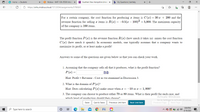
Advanced Engineering Mathematics
10th Edition
ISBN: 9780470458365
Author: Erwin Kreyszig
Publisher: Wiley, John & Sons, Incorporated
expand_more
expand_more
format_list_bulleted
Concept explainers
Question
both same page

Transcribed Image Text:Home - » Students
B Mobius - MAT-136-J5539 Intro f
m Southern New Hampshire Univer x
b My Questions | bartleby
8 https://snhu.mobius.cloud/727/2034/assignments/57869/0
For a certain company, the cost function for producing a items is C (x) = 30 x + 200 and the
revenue function for selling x items is R(x) = -0.5(x – 100)2 + 5,000. The maximum capacity
of the company is 160 items.
The profit function P(x) is the revenue function R(x) (how much it takes in) minus the cost function
C (x) (how much it spends). In economic models, one typically assumes that a company wants to
maximize its profit, or at least make a profit!
Answers to some of the questions are given below so that you can check your work.
1. Assuming that the company sells all that it produces, what is the profit function?
P(x) =
Hint: Profit =Revenue - Cost as we examined in Discussion 3.
2. What is the domain of P(x)?
Hint: Does calculating P(x) make sense when x = -10 or x = 1,000?
3. The company can choose to produce either 70 or 80 items. What is their profit for each case, and
which level of production should they choose?
Activate Windows
Go to Settings to activate Windows.
Previous Page
Save
Quit & Save
Previous Unit Item
Next Unit Item
Next Page
9:04 PM
P Type here to search
6/10/2021
近

Transcribed Image Text:Home - » Students
B Mobius - MAT-136-J5539 Intro i
m Southern New Hampshire Univer x
b My Questions | bartleby
Ô https://snhu.mobius.cloud/727/2034/assignments/57869/0
maximize its profit, or at least make a profit!
Answers to some of the questions are given below so that you can check your work.
1. Assuming that the company sells all that it produces, what is the profit function?
P(x) =
固岛。
Hint: Profit = Revenue - Cost as we examined in Discussion 3.
2. What is the domain of P(x)?
Hint: Does calculating P (x) make sense when x = -10 or x = 1,000?
3. The company can choose to produce either 70 or 80 items. What is their profit for each case, and
which level of production should they choose?
Profit when producing 70 items =
Number
Profit when producing 80 items = Number
4. Can you explain, from our model, why the company makes less profit when producing 10 more
units?
Activate Windows
Go to Settings to activate Windows.
Previous Page
Save
Quit & Save
Previous Unit Item
Next Unit Item
Next Page
9:04 PM
P Type here to search
6/10/2021
Expert Solution
This question has been solved!
Explore an expertly crafted, step-by-step solution for a thorough understanding of key concepts.
This is a popular solution
Trending nowThis is a popular solution!
Step by stepSolved in 3 steps with 5 images

Knowledge Booster
Learn more about
Need a deep-dive on the concept behind this application? Look no further. Learn more about this topic, advanced-math and related others by exploring similar questions and additional content below.Similar questions
arrow_back_ios
arrow_forward_ios
Recommended textbooks for you
 Advanced Engineering MathematicsAdvanced MathISBN:9780470458365Author:Erwin KreyszigPublisher:Wiley, John & Sons, Incorporated
Advanced Engineering MathematicsAdvanced MathISBN:9780470458365Author:Erwin KreyszigPublisher:Wiley, John & Sons, Incorporated Numerical Methods for EngineersAdvanced MathISBN:9780073397924Author:Steven C. Chapra Dr., Raymond P. CanalePublisher:McGraw-Hill Education
Numerical Methods for EngineersAdvanced MathISBN:9780073397924Author:Steven C. Chapra Dr., Raymond P. CanalePublisher:McGraw-Hill Education Introductory Mathematics for Engineering Applicat...Advanced MathISBN:9781118141809Author:Nathan KlingbeilPublisher:WILEY
Introductory Mathematics for Engineering Applicat...Advanced MathISBN:9781118141809Author:Nathan KlingbeilPublisher:WILEY Mathematics For Machine TechnologyAdvanced MathISBN:9781337798310Author:Peterson, John.Publisher:Cengage Learning,
Mathematics For Machine TechnologyAdvanced MathISBN:9781337798310Author:Peterson, John.Publisher:Cengage Learning,


Advanced Engineering Mathematics
Advanced Math
ISBN:9780470458365
Author:Erwin Kreyszig
Publisher:Wiley, John & Sons, Incorporated

Numerical Methods for Engineers
Advanced Math
ISBN:9780073397924
Author:Steven C. Chapra Dr., Raymond P. Canale
Publisher:McGraw-Hill Education

Introductory Mathematics for Engineering Applicat...
Advanced Math
ISBN:9781118141809
Author:Nathan Klingbeil
Publisher:WILEY

Mathematics For Machine Technology
Advanced Math
ISBN:9781337798310
Author:Peterson, John.
Publisher:Cengage Learning,

